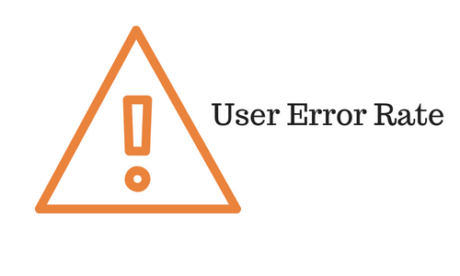5 UX KPIs You Need To Track

In a way, everyone loves measuring and assessing things, isn’t it? Undoubtedly, it is one of the easiest ways to understand the pros and cons of something. Although it might be a bit difficult to anticipate the entire outcome based on numbers, they somehow, help you gauge different situations. So, when it comes to user experience, is the methodology similar? Maybe, yes. If you’re new to the UX Designing field, here’s a great way to kickstart your UX designing career
Although the fundamental structure of user experience comprises user interaction quality and how they are being satisfied to you, still, quantifying the efforts and measuring their development is quite important. Hence, these measurements are known as UX KPIs.
With these UX KPIs, you cannot only enhance the experience of users and improve it simultaneously but can even quantify the precise results in terms of what is working out and what is not. Keeping this in mind, there are certain KPIs that you must be tracking.
However, before that, let’s dive deeper and know a bit more about KPIs. Shall we?
What is UX KPI?
Key Performance Indicators, abbreviated to KPI, are computable measurements that assist organizations outline and gauge the development toward the objectives. In this way, key performance indicators that are used to assess the progress of user experience goals are known as UX KPIs.
So, in case you don’t know where to begin from, below-mentioned is the list of top 5 key performance indicators that you should be tracking in the world of user experience.
Top 5 UX KPIs To Track:
When talking about user experience metrics, they are usually co-related to the metrics that are being used in marketing, sales, or finance. Although both of these metrics delineate human attitude and behavior, they, in reality, differ from each other. You can research your target customer, understand their behaviors and map out the customer experience with the help of a User Experience toolkit.
UX success metrics offer an amazing insight into the usability problems’ magnitude and size along with helping proficiently to track changes throughout the time. Being a UX design team, you don’t have to indulge in the sea of metrics and KPIs. On the contrary, you can work well enough with the two considerable type of UX KPIs, known as Qualitative & Quantitative.
Let’s explore both of them profoundly.
Qualitative Key Performance Indicators:
In a way, qualitative information is usually a bit more tough to accumulate since it is more informative and valuable as compared to natural numbers. Therefore, the measurement and tracking of qualitative UX KPIs necessitate communicating and being in touch with real users through interviews of contextual users, usability testing, or, if possible, user surveys.
Keeping the entire procedure in mind, there is no denying the fact that qualitative KPIs are time-consuming and demand more efforts. Also, it is quite difficult to assess them just with mere numbers. Despite that, this is the kind of information that holds utmost importance for any company.
Since there is going to be a pool of information, you don’t have to deviate away from your target. Hence, using this you can simply keep a tab on protocol, users’ expectations, and the experience of users with the performance. And, don’t forget to measure how satisfied they are with your services.
Quantitative Key Performance Indicators:
Coming to quantitative UX performance indicators, they have been further divided into five different parts. Let’s get to know the importance of each one of them.
1. Task Success Rate:

Task success rate is also called as a task completion rate and is one of the most widely used key performance indicators. As the name would suggest it, this KPI is usually used to assess the percentage of tasks accomplished by users correctly. The task may range from anything to subscribe to a newsletter, filling up a form, or buying a product, as long as it has an endpoint or a well-defined goal. It basically depends upon your business and goals that you want to achieve.
So, before you go on with collecting data, make sure that you have defined the goal of success. And then, upon dividing the number of successfully completed tasks and the total number of trials, you will be able to figure out whether it was difficult or easy for people to complete the task.
Although you won’t be able to find the reason behind the failure of users, the statistics that you are going to collect will surely be useful.
2. Time on Task:

Most of the times, time on task metric is known as task time or task completion time. Basically, this metric is used to measure the number of times users are taking to complete a single task. It is expressed in seconds and minutes.
Although there are several different ways to analyze and present the data gathered from this metric, however, one of the easiest ways is to bring forth the average time that the users spend on every task.
Furthermore, when it comes to detecting problems, this one can be a helpful metric. Practically, it is believed that the lesser the time-on-task, the better is the user experience.
3. Use of Navigation vs. Search:

Moving further, this is another important metric that makes evaluating the effectiveness of information navigation and architecture seamless. Usually, the search option comes to their rescue when users try and fail to find something through navigation.
Hence, if you have an e-commerce website, you can use this metric to track how many users found a particular product by navigating to it and how many just searched it. And, what was the purchase rate from both the ways?
4. User Error Rate:

Commonly, with errors, you can easily evaluate the user performance. Errors are the only things that will let you know the number of mistakes that were made, whether they were made while the users were interacting with your products or not, how different designs brought up different errors, and how something is usable altogether.
Mostly, usability issues and errors are interlinked with each other and are even regarded as one sometimes. However, usability issues are nothing but the root foundation of user errors. With errors, the idea is to tell you about the users’ mistakes. It can be anything. For instance: putting in the web address in the field meant for IP address. However, again, you should be clarifying the action precisely that lead to the failure.
There are different ways through which you can calculate an error rate. Though it depends on the error opportunity number in a task and what is the ground basis on which you want to measure.
- If there is only one error in the task or there are many, but you want to track only one, then to measure the error rate, you should be using:
Total number of error occurred for users
Total number of opportunities for error for users
- If there are several errors in one task, you should be using:
Number of errors
Total number of attempted tasks
5. System Usability Scale (SUS):
SUS is one of the quickest ways and widely used to measure the usability of a product by your users. However, this metric works in coordination with the user survey and would not be able to perform with statistical data.
Bringing out the desired result from this metric requires the participation of users. It is one of the best ways to calculate the qualitative data, including how satisfied users are with your products. Generally, it contains 10 item questionnaires along with five options for response, ranging from
Strongly agree to Strongly disagree.
For this, you can either download a template from the internet or create a form using Google forms. Provide a set of questions to users who are actually familiar with your product. Make sure that these users don’t belong to your team. After all, it’s all about fair answers, right?
Calculate results and find out a common value. For this, add the result gained from each user and divide it by the number of users.
Which Metrics Should You Be Using?
While there is no denying the fact that you are going to come across countless UX success metrics, knowing which one you should use strictly depends on your goals. And then, it also depends on what you can measure easily and what you cannot measure.
To reach a conclusion, you can form a framework. However, make sure that you are putting in an amalgamation of objectives while you create a framework. Also, you should also keep in mind that at the end of the day, it is the outcome that should make you strive.
Conclusion:
If you have such shareholders or team members on-board, who aren’t aware of UX professional terms, bringing forth the result of UX KPIs would be a great way to assure them that the progress is happening.
On the top of that, it is easy to comprehend numerical data than to look out for some other type of result. By using these UX metrics, you can easily calculate the development and measure the return on investment.
Based on the type of service or product, you can assign different metrics to different teams. And, you can even define specific, and new KPIs that will assist you to measure the UX results efficiently. As long as the data that you have is quantifiable and helpful, you are on the right path.


Leave a Reply